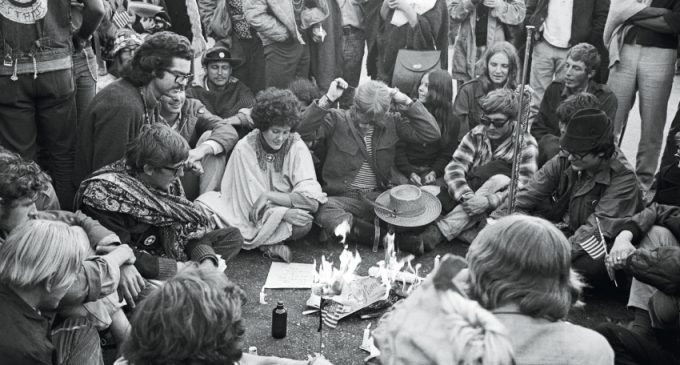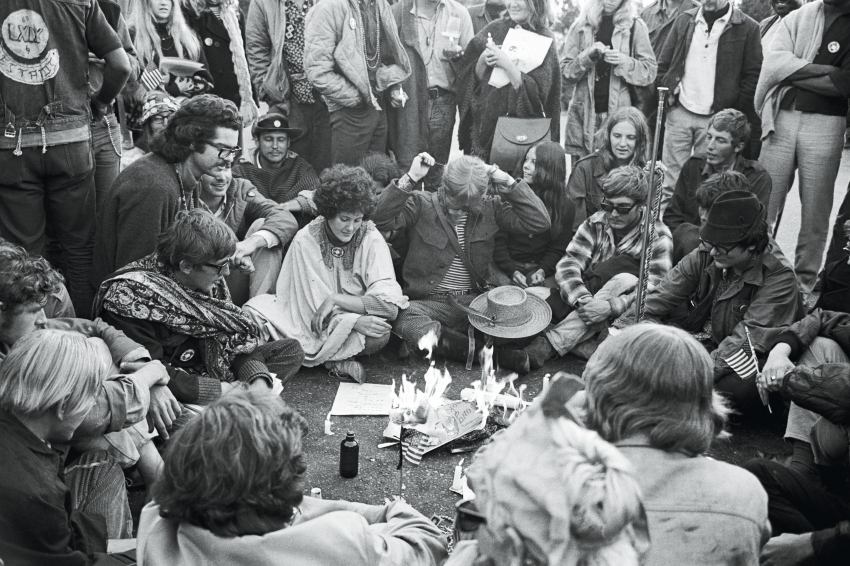The Long Summer of Love – The Chronicle of Higher Education

In the summer of 1967, tens of thousands of young people converged on the Haight-Ashbury district of San Francisco, drawn by sex, drugs, rock ’n’ roll, and the promise of a new way to live. This July a group of nearly 170 people, mostly academics, descended on the foggy city to try to figure out, 50 years later, what it all meant.They were here for a three-day conference, “Revisiting the Summer of Love, Rethinking the Counterculture,” organized by Northwestern University, which has a San Francisco campus, and the California Historical Society. The conference was widely said to be the first major academic meeting dedicated entirely to the counterculture. At the opening reception held at the society, a band led by a founding partner of Bono’s private-equity fund gently belted out the era’s most famous songs, starting with the Beatles’ 1968 hit “Revolution.”
David Farber, a 60-year-old professor of history from the University of Kansas, toured the society’s Summer of Love photographic exhibition, drinking a beer. The historian of modern America says “oh, man” a lot and bears a loose resemblance to Bruce Springsteen. He is considered a founding scholar in the emerging field of counterculture studies, which looks at the hippie past to view the present more clearly. Rather than focus on those whose youthful 1960s rebellions took a primarily political form, the work homes in on people who — fueled by an LSD-generated shared consciousness — were trying to create an alternative way of life (though the boundary between the two groups is blurry). How that culture was absorbed into modern life is what needs more and better study, these scholars say.
So many countercultural practices have become mainstream, they are difficult to see.The exhibition began with photos of the Beat Generation of the 1950s and culminated in the famous summer. By a glass case displaying a sheet of LSD blotter paper decorated with yin-yang symbols, Farber got talking with a woman hoping to help her grandson’s friend donate boxes of hand-scrawled acid recipes from Owsley Stanley, a famous LSD manufacturer and sound man for the Grateful Dead. Farber couldn’t resist taking her to meet Nicholas Meriwether, former curator of the Grateful Dead archive at the University of California at Santa Cruz. Meriwether is working to set up a private Center for Counterculture Studies devoted to archiving the period.In the main room, iconic photos hung on every wall — the musicians of the period, the Human Be-In in Golden Gate Park, Timothy Leary, Allen Ginsberg. Such imagery can override any attempt to think about and frame what happened more broadly, Farber explained. “It is more than just Janis Joplin and The Who and Jerry Garcia,” he said. “And it is more than 18 months.” Wouldn’t it be truer to the trajectory and history of the counterculture if the exhibition continued into the 1970s and early 1980s? A social history of the 100,000 people who showed up at the Summer of Love and then mostly went away and what they did next — what would that look like?
The counterculture of the 1960s — the term was coined by Theodore Roszak in his 1969 book The Making of a Counter Culture — has of course been written about at length. Memoirs and journalistic treatments abound. And sociologists and anthropologists were on the trail as the Summer of Love was unfolding. When histories of the 1960s began to be written, they often included a chapter on the counterculture. Those books tended to frame it as a short-lived movement that didn’t bring lasting changes: “A stoned romp by white, middle-class youths through the last few years of the 1960s,” as Farber has described it, which neatly ended with Woodstock, the Altamont Free Concert, or the Charles Manson murders. Take your pick.
More-nuanced historical scholarship on the counterculture really began in earnest only in the 2000s, following Imagine Nation (Routledge, 2002), a collection of essays by historians including Farber and co-edited by Michael William Doyle, an associate professor of history at Ball State University who was a flower child himself. It remains, to date, the only collection on the counterculture by historians. The scholarship was also influenced by Thomas Frank’s The Conquest of Cool (University of Chicago Press, 1997), which attempted to reframe the counterculture as a movement that right from the beginning sat firmly within the value system of consumer capitalism, and Farber’s The Age of Great Dreams (Hill and Wang, 1994), which argued that the importance and complexity of the counterculture had not been recognized.
The paucity of scholarship stands in contrast to the profusion of works on the civil-rights movement, the women’s movement, and the Vietnam War, over which herds of historians have pored for decades. “The gap is pretty amazing,” said Gretchen Lemke-Santangelo, a historian at St. Mary’s College of California and one of the San Francisco conference’s planners.
One reason for that gap is that the counterculture offers slenderer archival material. As an anti-institutional phenomenon, it never had a defined membership, and many of its products — short-lived underground newspapers, for example — were thrown away. It is also primarily a story about white, middle-class people: It doesn’t really fit in the larger narrative that many American historians have been developing around the making and breaking of equality, said Farber.
Another reason may be that the scholars entering the discipline in the 1970s tended to have backgrounds as activists and focused their scholarship on the political and social movements they had engaged with or admired. A culture of disdain — the New Left had a notoriously antagonistic relationship with the counterculture — then set in. “The idea that the counterculture was fluff, all about sex, drugs and rock ’n’ roll, prevailed until an even younger generation of scholars entered the academy,” said Lemke-Santangelo.
Hippies “seemed (and to many remain) silly and inconsequential,” wrote Alice Echols, a professor of history and gender studies at the University of Southern California, in an email. For a long time, Doyle said in a phone interview, the only people who seemed to accept that the ’60s counterculture had long-lasting, profound effects on American civilization were on the New Right.
Yet what started with a trickle of books in the early 2000s is now a stream. Recent titles include Groovy Science: Knowledge, Innovation, and American Counterculture (Chicago, 2016), edited by David Kaiser and W. Patrick McCray; Judy Kutulas’s After Aquarius Dawned: How the Revolutions of the Sixties Became the Popular Culture of the Seventies (University of North Carolina Press, 2017); and Joshua Clark Davis’s From Head Shops to Whole Foods: The Rise and Fall of Activist Entrepreneurs (Columbia University Press) which was published in August. The Sixties, a cross-disciplinary journal rooted in history and started almost a decade ago, offers a home for scholarly papers.A small cadre of younger scholars taking up the torch was in evidence at the conference. As Farber put it to conference attendees, “We are really riding a wave at this point.”
The impact of the counterculture has been profound, but because so many countercultural practices have become mainstream, they are difficult to see, said Doyle. “It has become the water to the fish, the air to the birds. We take it for granted. We move around in it, and we are not sure where it came from.”
Some observers argue that the counterculture was a failed revolution because it was co-opted by advertisers or never really subversive in the first place. But for the counterculture scholars, that’s beside the point, which is to figure out how the movement reshaped society. “It changed how tens of millions of Americans lived,” said Farber. “You need to understand the counterculture to understand fundamental trajectories of American life.”
Among the hippie hangovers that the scholars identify, some are obvious: yoga, meditation, and other mindfulness-based practices; vegetarianism and organic food; the return of midwifery and patient-centered medicine; and a variety of institutions such as free clinics, food co-ops, and craft guilds. Others are more opaque: the liberalization of dress codes; changes in sexual mores; less hierarchical business structures, with their echoes of communal living; the embrace of environmental sustainability; and the softening of attitudes toward marijuana (obscured by the 1980s war on drugs).
It’s “foolish” to think that those changes didn’t have their origins in the counterculture, said Farber, who in his talk painted a picture of what happened in the 1970s and into the 1980s as people tried to sustain the kind of values and daily practices of the counterculture in a wider material world, where they had to make a living and where drugs were outlawed. “The countercultural flowering is not ’66 or ’67 but what came next,” he told the audience.
For example, when rural hippie communes came into contact with nearby lesbian-feminist communes in the early 1970s, hippie women were given courage, said Lemke-Santangelo, author of Daughters of Aquarius (University Press of Kansas, 2009). Emboldened, those women took their customs outside their communes, unleashing non-Western spirituality and healing practices as well as ideas about natural birthing and child-rearing into the wider world. “Unless counterculture women had felt empowered, the larger culture wouldn’t have been exposed to these ideas,” she said.
Meanwhile, a network of hippies in San Francisco began rubbing up against the emerging tech hub of Silicon Valley, as Fred Turner, a professor of communications at Stanford University, outlined in his book From Counterculture to Cyber Culture (Chicago, 2010). Back-to-the land communalists looking for ways beyond LSD to achieve shared consciousness saw computers as tools of personal liberation that promised connecting, sharing, and collaborating — the same logic that drives the tech world today.
Some nonacademic attendees at the conference had bones to pick. Fayette Hauser, who wore flowing clothes and had long, henna-red hair, came to San Francisco in 1968. She pointed out that there is plenty the tech world hasn’t inherited from its hippie forebears. “We weren’t motivated by profit,” she said.
A few scholars agreed that it is possible to overdraw the connections. Like every other social, political, or cultural movement, the counterculture did not go quite as its progenitors thought it should or would, noted Doyle. “We need nuanced histories of: once the idea gets loose, who picks it up and runs with it.”
Source: The Long Summer of Love – The Chronicle of Higher Education




There are no comments at the moment, do you want to add one?
Write a comment